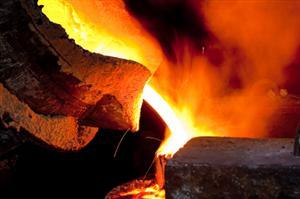| Complexity level: | 9 |
| Project cost ($): | 180 |
| Time required: | 1 day to prepare, 10 days for science fair project |
| Material availability: | Access to a hardware supplier or your school’s laboratory supplier. You will also need a Rockwell hardness tester and a high temperature dry box. |
| Safety concerns: | Ensure that the experiment is conducted in a properly equipped laboratory, under the supervision of your science teacher. Hot metal samples need to be handled with the use of proper equipment and protective gear. |
Hypothesis
The alloy’s hardness will increase when aged at higher temperatures.
Overview
Alloys
An alloy is a compound of two or more elements (metal or non-metal) chemically combined. An alloy produced from the combination of elements, may possess properties that are quite different from that of its constituent elements. Most of its properties like density, resistivity and thermal conductivity may be very different but they typically show significant improvements in physical such as shear strength and tensile strength.
During the manufacturing process of alloys, the period of aging and temperature will determine the initial hardness of the metal. The alloys can be given further heat treatment by aging them at high temperatures over time to increase their hardness and toughness.
Steel is an example of an alloy made from iron and carbon. The carbon used in steel acts as a hardening agent by helping to prevent the dislocation of the iron atoms from their crystal lattice. By adjusting the carbon content together with other alloying elements, steel that is stronger and harder than iron can be produced.
Scientific Terms
Materials
The materials required for this science fair project:
- 1 portable Rockwell hardness tester with accessories
- 1 sheet of Nickel alloy (Inconel 6.25)
- 1 sheet of Titanium alloy (Ti6A14V)
- 1 sheet of steel alloy (1018)
- Sand paper
- tap water
- A high temperature dry box oven
Procedure
1. For this science fair project, the independent variable is the aging temperature and type of alloy used – nickel alloy, titanium alloy and steel. The dependent variable is the hardness of the alloys after the thermal aging. This is determined by measuring the hardness using the portable Rockwell hardness tester. The constants (control variables) are the thickness of the alloy plates, the aging period and the room temperature.
2. The 3 types of alloys are washed and cleaned. Any oxidization or impurities are removed using sand paper.
3. The dry box oven is set to a temperature of 200°C and it is turned on. Once the temperature has reached the set level, the 3 types of alloy plates are placed inside the oven. The timer is set for 24 hours and the alloys are left to age.
4. After the 24 hours of aging, the oven is turned off, and the alloy plates are allowed to cool down to room temperature. After the plates have cooled down, the hardness of the alloy plates is tested using the portable Rockwell hardness tester. The value of their hardness is recorded in the table given below.
5. Procedures 3 and 4 are repeated by setting the oven temperatures at 400°C, 600°C, 800°C and 1000°C. The aging period is still 24 hours. After allowing the plates to cool down, the hardness of the alloy plates is tested with the portable Rockwell hardness tester and the measured values are recorded in the table given below.
Results
The results showed that the hardness of nickel and steel alloy started to decline after aging them at 800 °C. Titanium alloy hardness started to decline after aging at 1000 °C
| Alloy | Description | Alloy hardness after aging at different temperatures | ||||
| 200°C | 400°C | 600°C | 800°C | 1000°C | ||
| Nickel | Inconel 6.25 | A68 | A68 | A68 | A65 | A60 |
| Titanium | Ti6A14V | C36 | C36 | C36 | C36 | C31 |
| Steel | 1018 | B85 | B85 | B85 | B81 | B72 |
Conclusion
Our hypothesis that an alloy’s hardness will increase when aged at higher temperatures, is proven to be true only to a certain extent. When aged beyond a certain temperature, the alloys actually became softer.Steel is one of the most common alloys in the world and about 1.3 billion tons of steel is produced every year. It is used in building construction, ship building, automobile manufacturing, machines, tools and aircraft. Apart from improved hardness, steel is also more resistant to corrosion and it is also easier to weld. Steel is treated by aging at high temperatures over time to increase its hardness and toughness. However, heating the steel above a critical temperature will cause it to “anneal” and become softer
Also consider
This science fair project can be modified to test the maximum aging temperature for different types of alloys.
Would aging for longer periods of time and compare the hardness of the alloys.
References
Alloy - http://en.wikipedia.org/wiki/Alloy
Steel - http://en.wikipedia.org/wiki/Steel
Information about hardness - http://www.performancealloys.net/Hardness%20Information.htm

